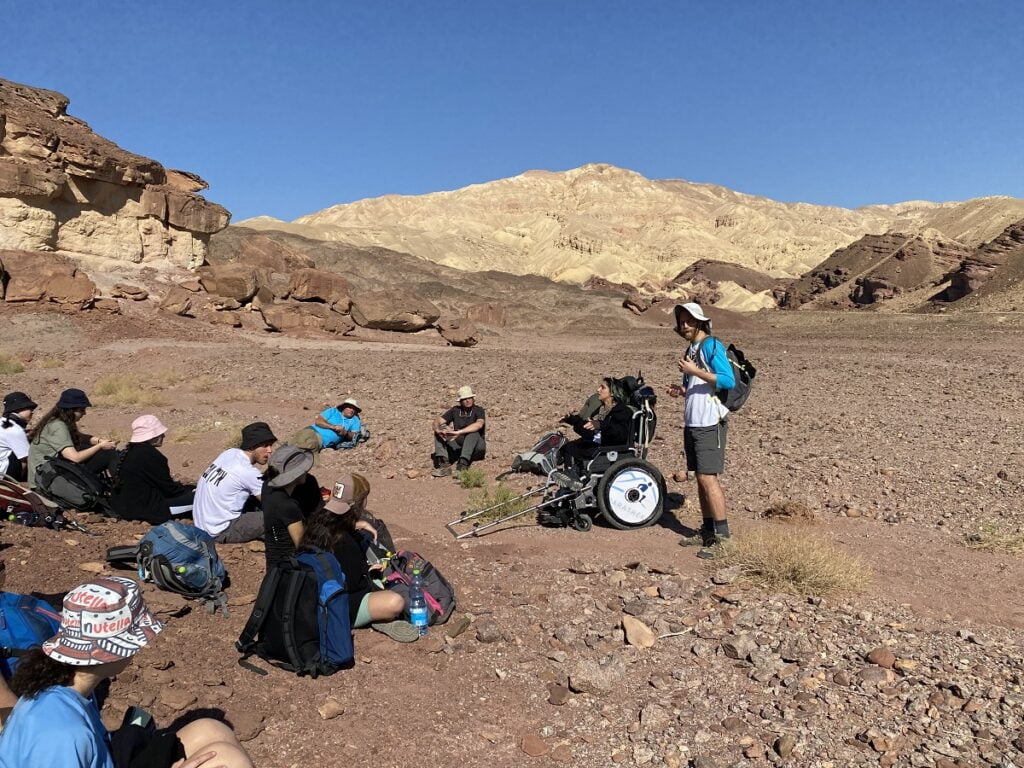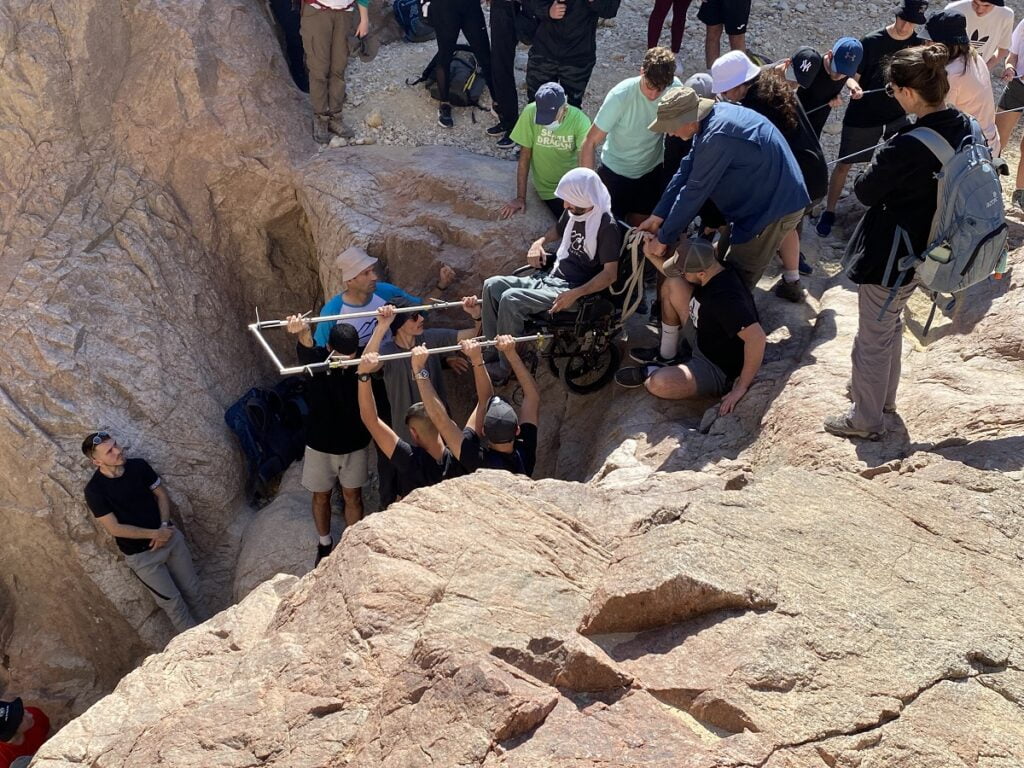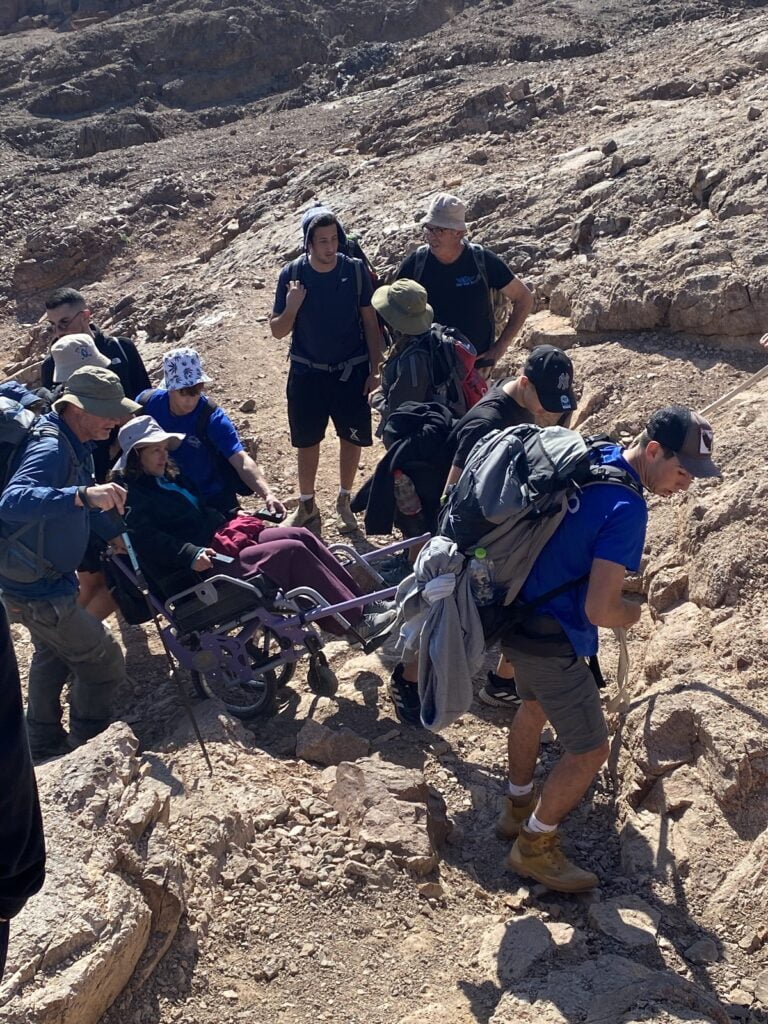It’s early morning, but the sun is already beating down on some 100 students and teachers who are about to begin their high school’s annual hike in the Eilat desert. The Ort Tivon students and faculty are excited — keen to embrace the outdoors, conquer the rocky hills, and form bonds. And this year they were especially thrilled to welcome three people who, in the past, might have thought twice about joining the trip.
This year, Ort Tivon’s annual hiking trip included three hikers who use wheelchairs to get around. Yaella Shimonov’s disability stems from childhood polio that forces her to walk with armbands. Arnon Amit lost feelings in his legs after a car accident on a break from active military service in Shaldag, an elite Israeli Air Force (IAF) special forces unit. Sarit Rosen, a computer science teacher at Ort Tivon who was seeing her students for the first time since the start of the COVID pandemic. Rosen had been diagnosed with ALS, the disease that causes loss of muscle control.
But they’ll have no problem joining others on this trek through the desert, thanks to an Israeli startup called Paratrek. The company has developed a special off-road wheelchair that can conquer rough terrain.
“We created Paratrek to make hiking accessible for all,” Omer Zur, the company’s founder and CEO, tells NoCamels in a later interview. Zur’s father had been struck by an Egyptian missile during the Yom Kippur War which left him paralyzed from the chest down. Years later, he was still able to go on a hike with his son.

“He never got the chance to go on his post-army trip, so 35 years later, I decided to take him,” Zur explains. The two of them joined 34 friends to hike 509 kilometers across Turkey, made possible by Zur’s innovative Trekker wheelchair.
The Trekker’s front and rear support enable companions to stabilize and lift hikers with disabilities during a journey.
Besides giving hikers with disabilities the opportunity to experience active trips with peers, high schools like Ort Tivon partner with Paratrek to add educational team-building segments to their treks. For students, an annual school hike can turn into a deeper understanding of what it means to navigate the world from a wheelchair. Every 15 to 20 minutes, the hike stops, and hikers share their stories.
I joined the students and teachers on this particular hike and watched in awe as they managed the trip with relative ease.
SEE ALSO: First-Ever Rehabilitation Hospital Opens In The Negev
“Students learn that they don’t need to run away from people that are not like them,” Shimonov says during the hike, “We’re all living the same life.”
As the trek continued, groups of two to three students took turns maneuvering Shimonov, Amit, and Rosen across the rocky terrain. At a few points, the students pulled the trekkers twenty to thirty meters up a steeper incline. They were joined by members of the Paratrek team, who oversaw the journey, but didn’t need to help much as only a few students were needed for assistance, even when the trail had a five-meter vertical drop that required hikers to use ladders.
Mission accomplished.
About the journey, not the destination
While many students can maneuver the wheelchairs on a trek, only a few really need to. Paratrek’s Trekker includes advanced engineering to ensure fun for the rider and ease for the volunteers. The chair’s large mountain bike wheels encourage the rider to be active on even the most difficult terrains.

These riders should be able to manage the same terrains as their peers who walk them, Zur explains. Paratrek’s Trekker includes two sets of wheels for both narrow and wider trails, noting that the “competitors do it on one wheel, and it’s not stable.” The wheelchairs are able to maneuver rocky, steep, uphill, and downhill paths, he adds.
Sign up for our free weekly newsletter
SubscribeIn 2008, the original Trekker model that Zur’s father rode was able to change wheels in 40 to 50 seconds. Today’s model “does the same in about four seconds,” Zur says, and includes specially designed ropes to make pulling more comfortable for the helpers. Typically, three to four people need to be on hand to push or pull the trekker on the trail. While this sounds like a difficult task for volunteers, Zur says Paratrek’s design makes it easy. “A five-year-old can pull full-grown men on a trekker,” he explains, “It’s magic.” The Trekker’s tilt is such that the weight is right above the center of gravity and only requires a little push
The sixth new generation Trekker comes out at the end of the month. It includes an optimized balanced seat, stronger and lighter materials, and gears for changing the height. “So if you’re on higher or lower [terrain], or a taller or shorter person,” it will be comfortable for the pushers, Zur explains.
Paratrek is one of the only companies in the world building hiking wheelchairs, but the company earns revenue in three different ways – selling the Trekkers, teaching workshops, and organizing hikes.
“If a student in high school or middle school wishes to join their school’s annual trip, we send a guide with a Trekker to join them,” Michal Raicher, Operation Manager at Paratrek, tells NoCamels. To enrich the experience.

Paratrek also sends educators – in this case, Shimonov and Amit for the Ort Tivon hike – to share stories and explain a day in the life of a physically disabled individual.
“The children are the future, and I can change their minds to see that they don’t need to run from people like me,” Shimonov says with a smile.
Paratrek operates in Israel, but organizes hikes all over the world, including in the French Pyrenees, Jordan, New York, Sinai in Egypt, and Kilimanjaro in Tanzania. “In a few days we’re going to be in Spain,” Raicher tells NoCamels.
For organized trips, Paratrek provides educational services and staff. They do not sell the Trekkers on those trips. The buyers are educational organizations and natural reserve parks that buy them ahead of time, specifically so their staff and participants with disabilities can join hikes.
Paratrek customers pay for the experience, but also for the hiking itineraries. Trekkers “give me the possibility to hike and travel with a loved one,” Shimonov says.
Nature reserves and parks often buy Trekkers for staff or customers because “it costs too much money to make hiking trails more accessible, nor is it good for the environment, ” Raicher tells NoCamels.
Paratrek sells Trekkers in Israel and abroad. “Right now we already have Trekkers in Australia and the United States. Zur says, We’re planning to send many more,” and “We already have contacts in the UK,” he tells NoCamels.
“We believe that every one of us has the right to trek and hike and enjoy an adventure in nature, whether with crutches, a specialized wheelchair, or any other means of transport”, he adds.
Related posts

Editors’ & Readers’ Choice: 10 Favorite NoCamels Articles

Forward Facing: What Does The Future Hold For Israeli High-Tech?

Impact Innovation: Israeli Startups That Could Shape Our Future




Facebook comments